Do you struggle to find your cooking essentials in the kitchen cabinet? This guide will reveal the secrets of how to organize kitchen cabinets most efficiently and effectively. Well-organized kitchen cabinets simplify your daily cooking routines and add a sense of serenity to your cooking.
Organizing and decluttering your kitchen cabinets can seem overwhelming, but we’ll walk you through it step by step. With this guide, you’ll learn what it takes to turn your kitchen into an organized and efficient hub. Let’s transform together!
How to Organize Kitchen Cabinets: Step-by-Step Guide
The below step-by-step guide will show you how to organize kitchen cabinets.
Decluttering Your Kitchen Cabinets
The first step to organizing your kitchen cabinets is to declutter them thoroughly. By eliminating unnecessary items, you free up space and make it easier to organize what remains. Here’s a step-by-step guide on how to declutter effectively and efficiently:
Assess Your Cabinet Contents
Empty all your cabinets first. You can lay it all out on your counters or a large table. This visual assessment lets you see what you have and what to keep.
Keep or Discard
- Keep: Make a list of essential and frequently used items. Think about their functionality, condition, and whether you really need them.
- Discard: You should decide what needs to be discarded. When you have an item that has been damaged, rarely used or doesn’t work, you should discard it.
Organize by Category

You can sort things into categories like pots and pans, dishes, utensils, food storage containers, etc. When you start putting things back in the cabinets, this categorization will help you organize.
Create Zones
Identify your kitchen’s zones based on how you use them. You could designate a baking zone for mixing bowls, baking pans, and similar items. It ensures everything has its place and makes the cooking process smoother.
Planning and Preparing for Cabinet Organization
You have neatly categorized all of your kitchen items, so now it’s time to consider how to utilize your cabinet space. Planning and preparation will ensure a well-organized kitchen. Here’s how to get started:
Measure and Assess Your Cabinet Space
Measure the height, width, and depth of each cabinet accurately. Consider any obstructions, such as pipes or vents, affecting the usable space. Use this information to select appropriate organizers and maximize cabinet space.
Analyze Your Kitchen Layout and Workflow
Understanding your kitchen layout and workflow is essential to optimizing your kitchen cabinet organization. Identify high-traffic areas in your kitchen. When you’re cooking or grabbing ingredients, these are the places you visit most often.
Customize your cabinet organization to match once you’ve identified these high-traffic zones. Keep pots, pans, and cooking utensils close to the stove for easy access. Keep dishes and cleaning supplies near the sink. Place items strategically based on their frequency of use and proximity to relevant kitchen spaces.
Choosing the Right Storage Solutions
After assessing your cabinet space and kitchen layout, it’s time to find storage solutions that make kitchen cabinet organization a breeze. Consider these versatile and efficient storage options:
Drawer Dividers
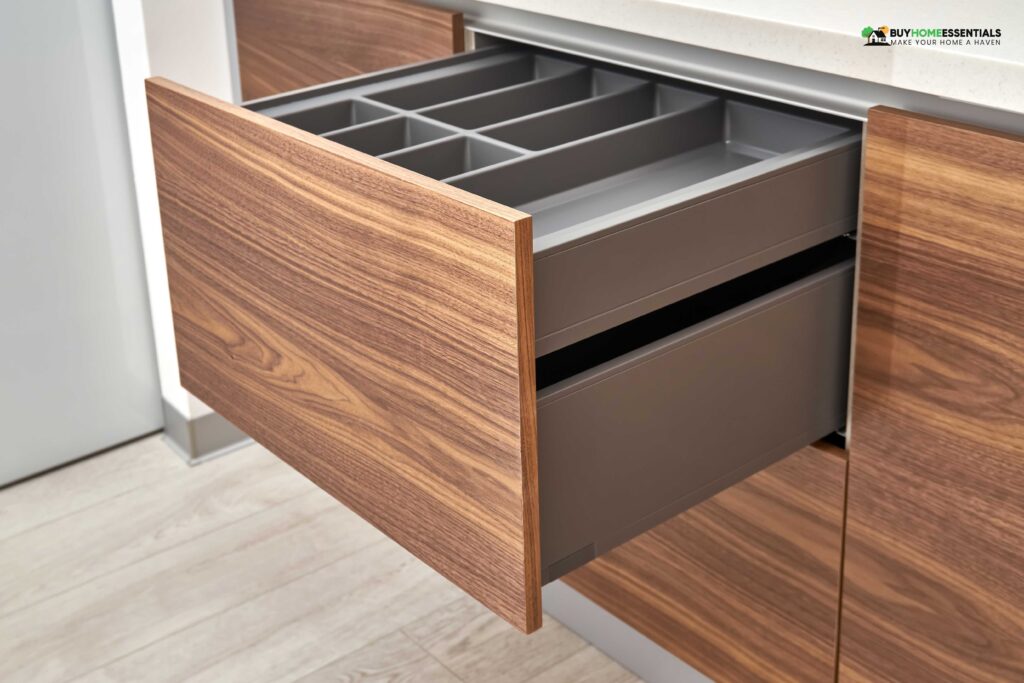
Drawer dividers are perfect for organizing utensils, cutlery, and smaller items. They help separate different categories of items, making it easier to find what you need quickly.
Shelf Risers
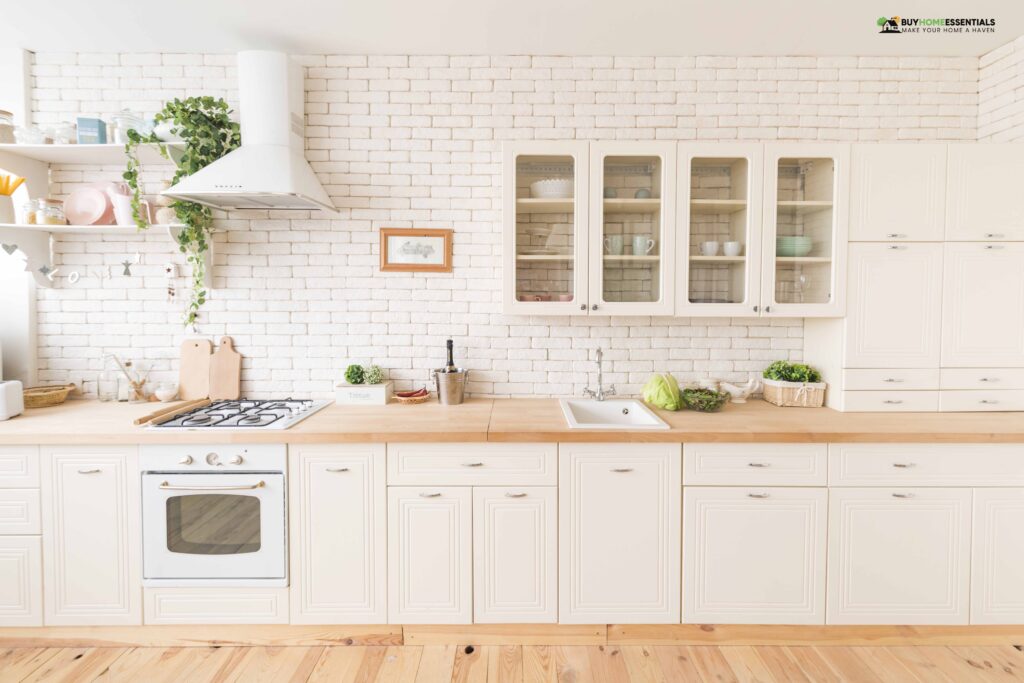
Shelf risers are excellent for maximizing vertical space within your cabinets. It allows you to create multiple levels, enabling you to access items at the back more quickly.
Lazy Susans
Lazy Susans are rotating trays that provide easy access to items, especially in corner cabinets. You can use them to store spices, condiments, or small items lost in your cabinets.
Pull-Out Shelves
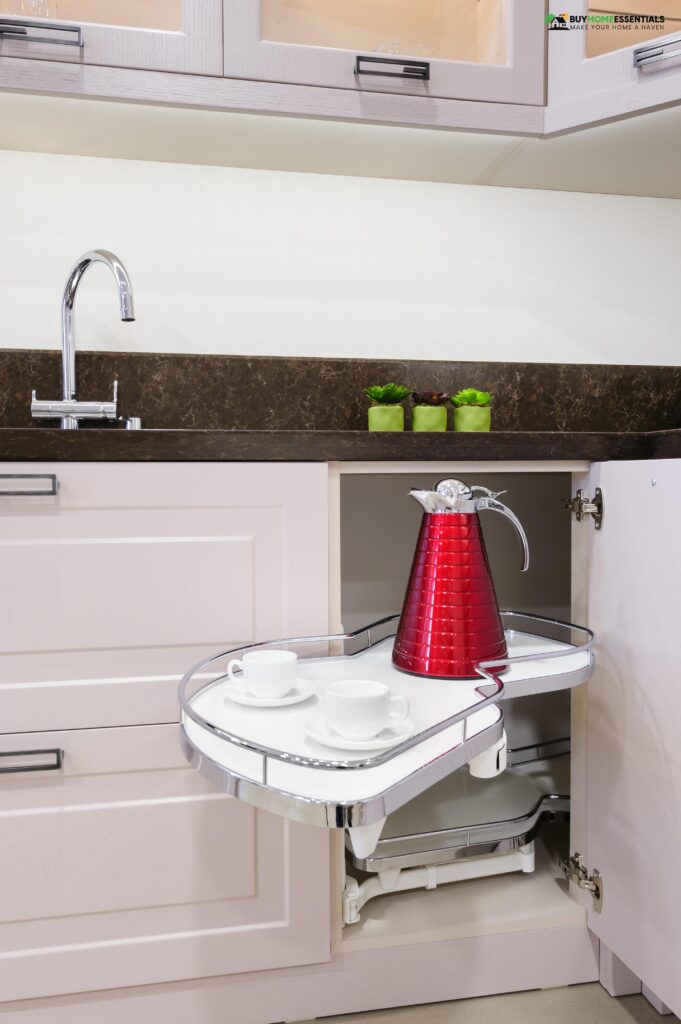
With these shelves, you can easily access items stored in the back by pulling them out. They work well for pots, pans, mixing bowls, and other bulky cookware.
Hooks and Racks
Racks and hooks can be attached inside cabinet doors or on cabinet sides to store lids, cutting boards, and small utensils. It’s a great way to use space that might otherwise be wasted.
Label Your Storage
It’s vital to label kitchen cabinets to keep them organized and efficient. Labels guide you and other household members to return items to their designated spots, and they simplify cooking and cleaning. How to make labeling work for your organized kitchen:
Choose Clear and Legible Labels
Consider clear, easily readable labels. Use a legible font for maximum visibility and ensure the labels contrast nicely with the background. Adhesive labels, chalkboard labels, or simple masking tape can be used for labels.
Label by Category or Zone
Label your cabinets based on the categories or zones you have established. For example, label a cabinet “Bakery” or “Spices” so you know what’s in it. Using this method makes it easier to find and return things.
Utilize a Labeling System
Maintain a consistent labeling system throughout your kitchen. An organized labeling approach enhances the efficiency of your kitchen organization, whether you use color-coded labels or shelf numbers.
Regularly Review and Update Labels
Regularly review your labels and adjust them as your kitchen needs change. Remove labels from items you don’t use or have, and put new ones on things you’ve recently bought. Keeping labels up-to-date ensures that your organizational system works.
Tips for Maintaining an Organized Kitchen Cabinet
Organizing kitchen cabinets is an ongoing process. You can maintain the hard-earned organization in your kitchen by following these tips:
- Remind yourself to review your cabinets regularly. Maintain your organized space once a few months to ensure items have not piled up and become cluttered.
- Consider removing an older or less-used kitchen item whenever you acquire a new one. It prevents unnecessary accumulation.
- Take a few minutes each day to tidy up the kitchen. Put items back in their designated places and wipe down countertops to maintain order.
- Schedule a specific day each week for more thorough kitchen organization. Restock supplies, reorganize if necessary, and prepare for the week.
How to Organize Kitchen Cabinet Drawers
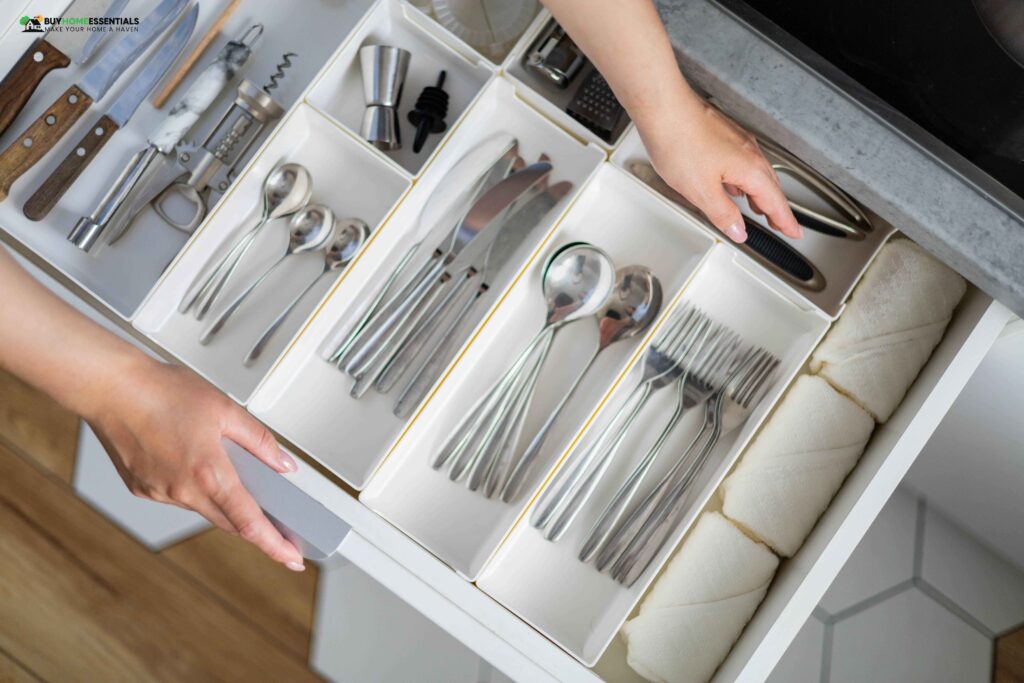
Organizing your kitchen cabinet drawers can make cooking easier. Follow these steps to maximize space and create a well-ordered drawer system:
- Empty the drawer completely first. Discard broken or unused items and categorize the rest into groups like utensils, gadgets, or linens.
- Use adjustable dividers, trays, or utensil organizers to separate items. For easy access, store frequently used utensils at the front.
- Keep items you use every day in the top drawers. Put less commonly used items in lower drawers and reserve hard-to-reach areas for seasonal items.
- Label containers or use transparent ones to identify contents quickly. As a result, it is easier to find specific items without having to rummage through drawers.
- Organize your drawers every few months, declutter if needed, and reorganize if necessary.
How to Organize Food Kitchen Cabinets
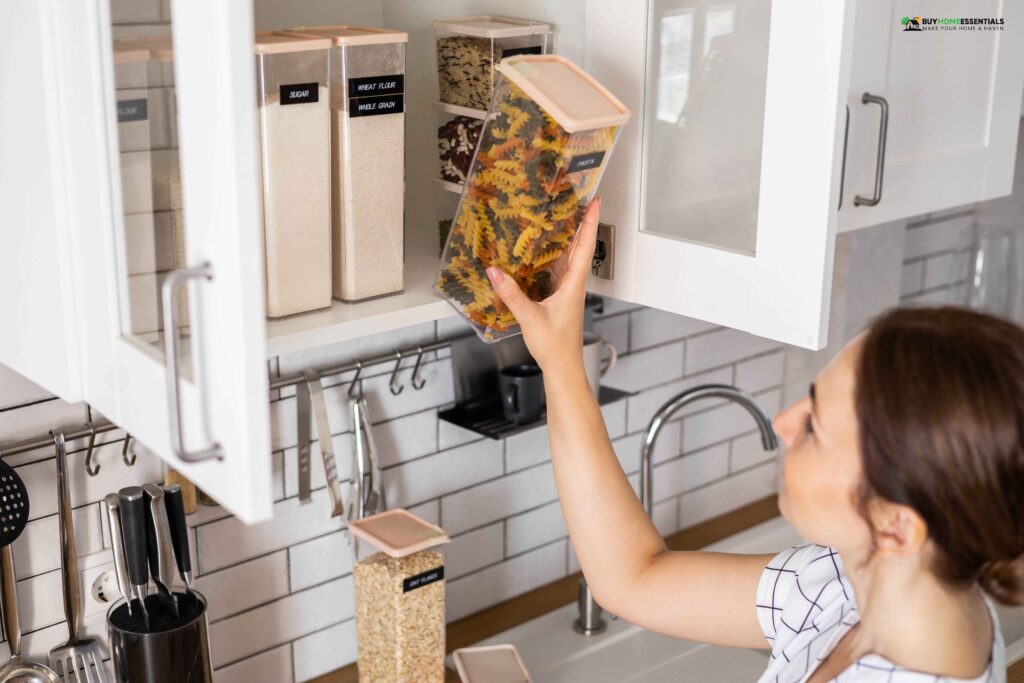
Organizing your food cabinets efficiently enhances meal preparation and reduces waste. Organize your food storage system by following these steps:
- Sort food items into groups, such as grains, canned goods, spices, snacks, etc. The system allows for an organized approach.
- Ensure items with earlier expiry dates are used before items with later expiry dates. Check expired items regularly and declutter them.
- You should store grains, cereals, and snacks in clear, airtight containers so they are easily visible and accessible. Label the containers for quick identification.
- Assign specific areas to each food category. You can organize flour, sugar, and baking essentials in a baking zone so they are easier to find.
- Check your food cabinets frequently, dispose of expired items, and rearrange them based on usage and accessibility.
How to Organize Kitchen Cabinets Dishes
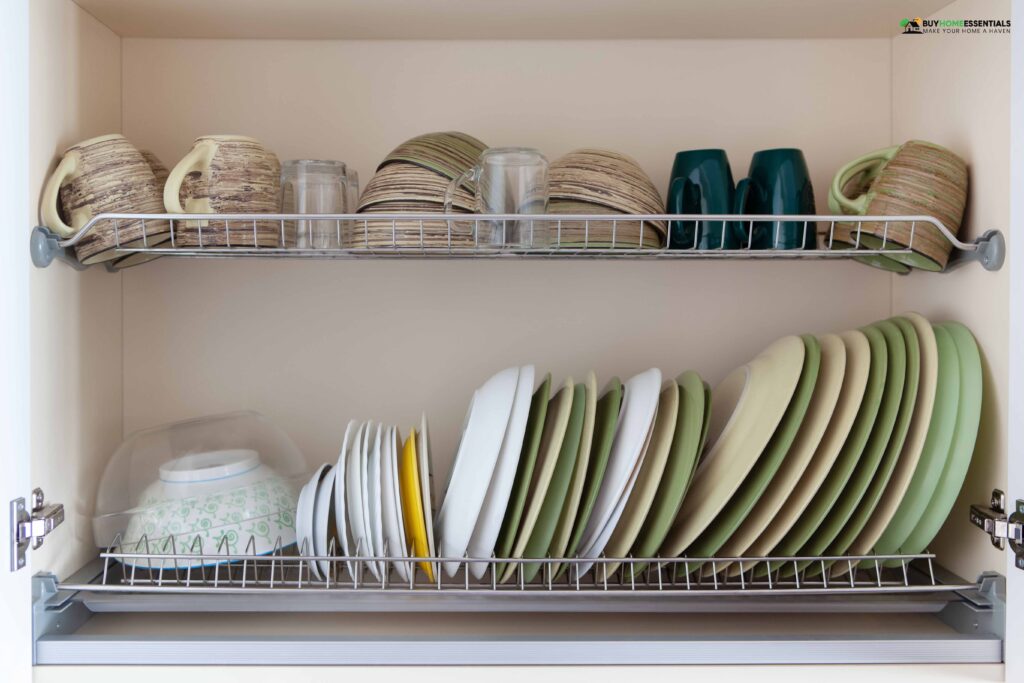
Organizing your kitchen cabinets for dishes is essential to make it functional and aesthetically pleasing. Keep your dishware organized and accessible with these steps:
- Take out all your dishes first. Discard chipped or unused items. Assess your collection and keep only what you use regularly.
- Categorize dishes by type (plates, bowls, glasses, etc.). Arrange them in separate sections within the cabinet for easy access and neat storage.
- Stack smaller plates and bowls neatly to save space. Use dividers or adjustable racks to keep lids and pans organized.
- For convenience, place everyday dishes at eye level. You can place less frequently used items higher or lower.
- Reevaluate your dishware every few months, rearrange it if needed, and declutter it to keep it efficient.
Related: How To Organize a Pantry With Deep Shelves
The Takeaway
That’s all from today’s round-up on how to organize kitchen cabinets. An organized and efficient kitchen comes from well-arranged cabinets. Keep in mind that maintenance is key. The best way to organize kitchen cabinets is to regularly declutter, review, and adjust your organizing system.
Organizing cabinets effectively, including labeling and maximizing space, will make cooking easier and more efficient.





